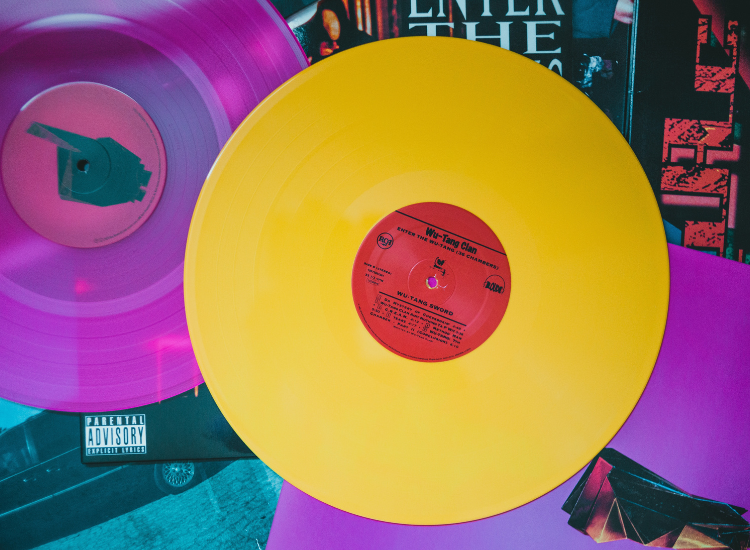If you’re in the market for some new records you may be debating between black and colored vinyl. Black vinyl is classic and has been the typical record type; however, in modern times colored vinyls and even ones with swirls, splatters, and more have become the rage. You may wonder what the difference is between the two, so we’ll break it down for you.
Black Vinyl History & Coloring
When starting out the creation process, vinyl records actually start out clear. When the common “ingredient” of vinyl records, PVC, is mixed with carbon a black hue is developed. There are different theories that debate how this coloring originated and why exactly carbon was added to the recipe. Some argue that carbon was added to the mix for increased strength and durability, others believe the carbon helps to reduce friction, and another theory states that the blackness that carbon produces hides flaws in the vinyl.

So, when did people start using vinyl? Vinyl records became popular in the 1930s as this is when the first long-playing record was introduced. It took 18 years for the first song to be released on vinyl in 1948. This song was “PeeWee The Piccolo”. Although black vinyls are the original, colored vinyls have grown in popularity over the years.
Colored Vinyl History & Coloring
Instead of adding carbon during the vinyl production process, record makers add colored dyes into the PVC. The dyes used depend on the coloring of the record and whether the manufacturer is going for a translucent or opaque look.
Even before vinyls started to become popular in 1930, colored-vinyls were being produced. The very first colored vinyl to be produced was released in the early 1920s. Vocalion Records released this mahogany colored vinyl record under the premise that it would play longer than black records. In the years following, additional record companies began to produce colored vinyl and even started mixing colors to get a marbled look.
Over the years, record companies have perfected these artistic vinyls and now produce records that are marbled, splattered, swirled, half and half and more.

Is Black Vinyl Better Than Colored Vinyl?
Black vinyl is not necessarily better than colored vinyl. There are a few elements to consider when discussing the quality of these two differing types of vinyl records.
Does Colored Vinyl Sound Better?
There is not a distinguishable difference between the sound of black vinyl and colored vinyl. Those who are experts in audio and sound may notice a difference, but typically it is not noticeable to the human ear. Some things that may affect the sound quality of a vinyl record include the skill level of the manufacturer, the quality of the materials used during production, quality control protocols, and the age of the vinyl record. It is important to note that as colored vinyl continues to grow in popularity, the skill level of the manufacturers producing the record has improved. Records produced several years ago may not be up to par with those produced today in terms of sound quality.
Black Vinyl Can Be More Durable Than Colored Vinyl
Carbon is a strong element, so it should come as no surprise that when mixed with PVC the carbon strengthens a record. It is safe to say that vinyl made with carbon is more durable than vinyl made with colored dyes.
Colored Vinyls Tend To Be Worth More Money
Colored vinyls are typically used for limited edition releases or special prints. Also, record manufacturers tend to be set-up to produce black vinyl. So, there might be increased set-up and production costs to produce colored vinyls that may get passed on to the consumer. This makes colored vinyls more expensive, and thus more valuable.
Black Vinyl May Have Fewer Flaws
Since black vinyl features only one color, it is easier to notice any errors. Colored vinyl that features swirls or marbling can create some difficulty in spotting flaws.
Should You Buy Black Or Colored Vinyl Records?
Each has their own unique characteristics, and it depends on where your interest lies. If you are looking for a record that screams “classic vinyl” black is the way to go. If you want something a bit more artistic and visually pleasing than consider a colored vinyl; go even further and get a multi-colored vinyl. Diversify your vinyl collection with a mix of multiple colors of vinyl.
